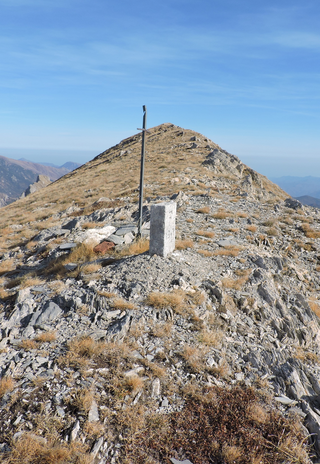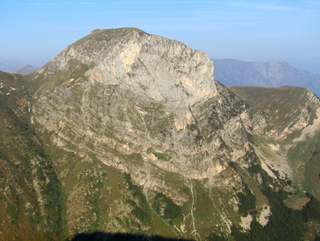
Monte Bignone is a mountain in Liguria, northern Italy, part of the Ligurian Alps. It is located in the province of Imperia near Sanremo. It lies at an altitude of 1299 metres and lies within the San Romolo Natural Park.

Monte Frontè is a mountain in Liguria, northern Italy, part of the Alps. It is located in the province of province of Imperia. It lies at an altitude of 2,152 metres. After Monte Saccarello it is the second highest peak in the Ligurian region.

Monte Saccarello (Italian) or Mont Saccarel (French) is a mountain located on the French-Italian border between Liguria, Piedmont and Provence-Alpes-Côte d'Azur.

Monte Orsiera is a mountain in the Cottian Alps belonging to the Province of Turin (Italy).

Monte Tanarello (Italian) or Mont Tanarel (French) is a 2094 metres high mountain located on the French-Italian border.

Cima di Pertegà (Italian) or Cime de la Pertègue (French) is a mountain located on the French-Italian border between Piemonte and Provence-Alpes-Côte d'Azur.

The Cime de Capoves (French) or Cima Capoves (Italian) is a mountain of the Ligurian Alps located in the French region of Provence-Alpes-Côte d'Azur, close to the French-Italian border.

Monte Monega is a 1,882-metre (6,175 ft) mountain of the Ligurian Alps, in Italy.

Carmo di Brocchi is a 1,610-metre (5,282 ft) mountain of the Ligurian Alps, in Italy.

Monte Spinarda is a 1,357-metre (4,452 ft) mountain of the Ligurian Prealps in Italy.

Monte Bertrand (Italian) or Mont Bertrand (French) is a mountain located on the French-Italian border between Piemonte and Provence-Alpes-Côte d'Azur.

The Cime de Mussun (French) or Cima Missun (Italian) is a mountain of the Ligurian Alps.

The Bric Costa Rossa is a mountain of the Ligurian Alps located in Piedmont.

The Cima della Fascia is a mountain of the Ligurian Alps located in Piedmont.

The Monte Mongioie is a mountain of the Ligurian Alps located in Piedmont.

The Monte Antoroto is a mountain of the Ligurian Alps located in Piedmont.

The Cima delle Saline is a mountain of the Ligurian Alps located in Piedmont.

The Punta Mirauda is a mountain of the Ligurian Alps located in Piedmont.

The Cima Cars is a mountain of the Ligurian Alps located in Piedmont.

The Monte Fantino is a mountain of the Ligurian Alps located in Piedmont.

























